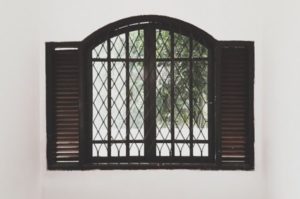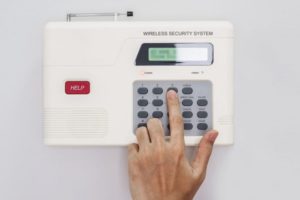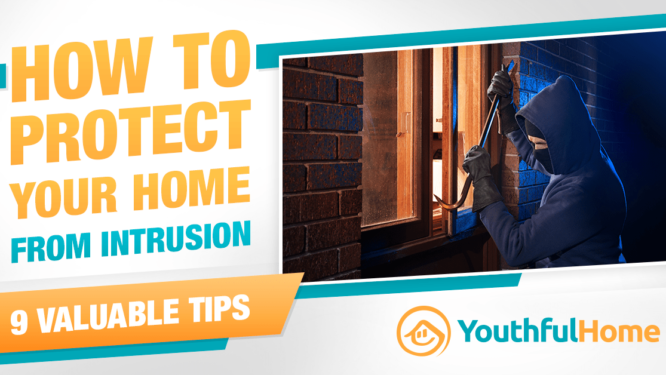Discovering that you’ve been the victim of a break in is a traumatic event. And it’s not just the theft of your valuables. The thought that someone has violated your private space can also steal your peace of mind for a long time. Such an event—whether real or imagined—calls for added security, which can be expensive. Additionally, an investment you make to secure your home can also increase its market value.
#1 Secure Your Exterior Doors
A lone knob or lever on an exterior door is not much of a challenge for a thief. With the proper tools, the spring bolt can easily be retracted from the strike plate. Or the knob/lever can be broken from the door with a couple of hammer blows.
If you have a solid wooden door, especially with a metal or fiberglass skin, consider replacing the existing cylinder lockset with a mortise lockset—which has an integrated deadbolt. The deadbolt in a mortise lockset cannot be retracted from the strike plate without disassembly of the lock.
A mortise lockset is not the best upgrade for a weak wooden door because the pocket for the mortise lock can weaken the door itself. If you have such door it’s best to upgrade it to a thicker, heavier and more reliable one. Or at least install a cylinder deadbolt. The cylindrical deadbolt is not as secure as a mortise lockset, but it requires less material removal from the door and is easier to install.
As an additional measure, add another deadlock or a rim latch to reinforce the door and increase the time a burglar needs for picking or breaking all locks.
Whatever you do to upgrade the security of your exterior doors, don’t forget the screws! Make sure that every screw used to mount door frame hardware is long enough to extend through the door frame into the rough opening. To ensure the lock reliably protects your home after proper installation, it’s best to find a service of a professional certified local locksmith to entrust the task to.
If you want to learn more about residential lock types, here is an in-depth guide provided by Skilled Locksmith, a leading locksmith company in Texas.
#2 Secure Windows

A thief will break into your house the quickest and easiest way possible. Thieves don’t like to break glass, so they will try to get in through a door as their first choice. But if the door appears impenetrable, the thief will choose a window. Make sure your windows are as secure as possible.
Window Locks
If you have casement or awning windows in your home, you do not need window locks. It is easier for a thief to break the glass than to get past the mechanism that opens and closes casement/awning style windows. But double-hung windows need locks because it’s relatively easy to pry up the bottom sash.
Window locks are not attractive. And if you don’t have window coverings you may find the look of window locks offensive.
Blinds and Curtains
What will a thief see if he looks through your window? Will he see a pile of laundry on the bed or an iPad and laptop on the dresser? Keep a thief guessing about whether it’s worth breaking into your house. Store valuables out of sight when possible or cover your windows with blinds or curtains. And remember to close those blinds or curtains when you are not home.
Plant Thorny Bushes
If you’ve ever had a holly bush come between you and a window, you know how annoying it is to try to clean the glass without getting pricked. A thief will have the same experience trying to get into your house through that window. If you can make it work with your landscape vision, plant thorny bushes under any windows vulnerable to break in.
Replace Glass with a Stronger Material
As long as a thief is wearing something to protect their skin, single strength glass is easy to break with an elbow. If your windows are in good shape otherwise, consider replacing single strength glass with a plastic alternative—such as polycarbonate, acrylic, or Plexiglas. Keep in mind that plastic sash will scratch easily. So if you want a clearer look, install reinforced or laminated glass.
Consider installing new windows that have tempered insulated glass. Besides lowering your risk of a break in you will also lower your utility bills.
Install Iron Window Guards
The ultimate protection for your windows is to install iron window guards. A thief can still break the window, but they can’t crawl through the bars. And no thief will take the time to saw through the metal bars. If it doesn’t bother you to see bars when you look out your windows, check out the decorative window guards that can be customized to suit your home’s design.
Security Metal Roller Shutters
Walk down a busy street in an urban area after the shops are closed and you will see aluminum security roller shutters on almost every store front. Many companies manufacture this type of shutter for residential use. And if you live in a hurricane zone, a security roller shutter can also double as a hurricane shutter.
While offering as good or better protection against a break in as iron window guards, roller shutters tell would-be thieves you are not home. But if your doors are adequately protected, thieves will move on to an easier opportunity.
Window Alarms
Most security systems have glass breakage sound sensors included or available as an option. These alarms are not mounted on the windows, and therefore offer the least intrusive design. If someone tries to break a window, a monitored security system will automatically alert an emergency response.
But you can also install individual window alarms that will activate when the window is opened or broken. Individual window alarms can also alert you of a problem by phone if you are away from home.
#3 Install a Security System

Security systems are wired, wireless, or a combination of the two. Because a wired system is more reliable and maintenance free, new construction should always be pre-wired for a security system. Installing wiring in an existing home is possible, but expensive. A wireless system costs less and will still protect your home.
The money you spend on an alarm system may or may not increase your home’s value. But it will definitely save you money on your property insurance—especially if your security system is monitored.
Home security systems come in a variety of types and with different features. When doing your research, you will have to find answers to multiple frequent questions about them. But to give you general understanding quickly, here is a concise rundown of the main types and features of home security systems
Self-Monitored vs Monitoring Service
A self-monitored system can alert you with a physical alarm when you are present in your home, or with a telephone alert when you are absent. But a self-monitored system will not automatically call emergency personnel to your home if there’s a fire or a break in. While a security monitoring service charges a modest monthly fee, the extra expense can be the difference between a burglary interrupted, and a burglary completed.
DIY Installation Kits
If you are handy around the house, you can buy a DIY installation kit. Install it yourself, and pay a security monitoring company to monitor the system or monitor it yourself. This is by far the least expensive way to set up a security system. You can find installation kits online and at home improvement stores. Check with several monitoring services; some of them offer free installation of their own kits.
Video Surveillance
Something about a camera makes a thief want to move on to another house. While video surveillance is expensive, it’s one of the best deterrents to a break in. To reduce costs, mix in with the functioning ones.
Remember, the value of a camera is not to take pictures of thieves and your belongings on their way out. The value of video surveillance is to make a thief think twice before ever entering your home.
Motion Sensor Lighting
If you live in a rural area with lots of wildlife, motion sensor lighting can be annoying while you’re trying to sleep. Deer and other animals will turn the lights off and on all night long. But motion sensor lighting is a great deterrent to unwanted two-legged creatures.
You can retrofit existing outdoor lighting with motion sensor controls, or you can install new lighting that is hard-wired or solar.
Environmental Hazards Protection
Invest in carbon monoxide detectors. Install them in various places around your house. They are inexpensive and effective at detecting CO that could come from a cracked heat exchanger in your furnace or from some other source. At the least, install battery-operated smoke detectors in your bedrooms. As for other types of air pollution, check your house for radon gas with an inexpensive test kit that can be purchased at your local home improvement store.
#4 Advertise Your Security Measures
From the street, would-be thieves do not know what type of security system you have. Do not wait until they get one foot in the door to let them know. Make sure you advertise your security measures. Make sure home security signs are visible from the street. Just don’t specify the make and model of your security system or you risk getting hacked.
#5 Consider to Get a Dog
If you don’t already have a dog, a dog can be a great security system against a home invasion. But while a thief can set off a barking dog, so can a squirrel. And what was meant to be an alarm can become an alarm clock going off at all hours of the night. With feed bills and vet bills, dogs can also be a big monthly expense. But a large dog who stays outside will definitely deter a criminal. And a small dog who stays inside will wake you up to any outside activity.
Keep in mind that dogs are not predictable like security systems. And dogs are a liability risk if they attack someone who doesn’t intend to harm you.
#6 Build a Fence
A fence is little deterrent to a robbery unless it completely surrounds your property. And local zoning codes usually prohibit fences next to the street unless your lot and house are large. If your neighbourhood allows it, a decorative fence made of metal, stone, or brick is a great deterrent to would-be thieves—as long as you combine it with a security gate. Even if they can get in, no thief wants to hoist stolen merchandise over a fence.
#7 Don’t Hide Spare Keys Outside
“Officer, how did they get my front door open without damaging it?”
“Sir, they used the key you hid in the flagpole socket.”
While it makes sense to hide a key outside somewhere in case you lock yourself out of your house, don’t be too sure that a thief hasn’t already predicted your hiding place. If you insist on hiding a key outside, just make sure you don’t use a solution that has been posted online. Be a little more creative.
#8 Be Careful With Strangers
If you can’t see who is ringing your doorbell, install a peephole so you won’t be caught by surprise when you open the door. Find out who the person is and what they want before inviting them into your house. If it’s a sales call, ask them for a business card. Thieves can pose as salespeople to determine if you have enough valuables to risk a burglary. At the same time they can assess your security measures to determine their break in strategy. Never, ever open the door to a stranger at odd hours.
#9 Get to Know Your Neighbors
While neighbors can be nosy, a good neighbor is a great asset when it comes to home security. Get to know your neighbors and they are more likely to keep an eye on your house when you are not at home. You can return the favor and make great friends in the process.
A neighbor that becomes a friend will look after your interests just like they do their own. When you will be away from home, they can park a car in your driveway and check your mailbox to create an illusion of your presence, and make sure your house is secure.
I hope this article gave you a few fresh ideas on protecting your home from intrusion. But if you also own a business, there is much more information for you to learn on the subject of securing your property. This guide can educate you on kinds of security hardware for commercial facilities.

